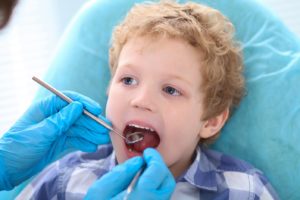1 in 2 Australian children have tooth decay and decay rates have increased by over 50% since 1996. It’s not just baby teeth that are affected, with 50% of 12-year-olds having tooth decay in at least one adult tooth. These statistics are alarming and suggest that much more can be done to prevent dental disease in our community.
We are often asked when is the best time for a child’s first dental appointment. The answer is a lot earlier than most people think, at 1 year of age! This is because at age 1, a baby’s front teeth have usually started to come through, and these teeth often show signs of tooth decay caused by frequent on-demand breast or bottle feeding. While feeding is always to be encouraged, there are additional measures that can be taken to help prevent decay in the infant which your dentist can explain.
Your child’s baby teeth are as important as the adult teeth which will replace them. They enable your child to chew and speak properly. Keeping baby teeth also helps the adult teeth come through in the correct positions, reducing the chance of crooked or crowded teeth in the future. Daily care at home and regular dental check-ups will help prevent tooth decay in your child which can result in early loss of baby teeth.
 Starting dental visits early will help a child develop good dental habits, setting them up for a lifetime of good oral health. Early visits also help a child become more familiar with the dental clinic environment, making future visits a more relaxed experience. We take time with our young patients to let them become familiar with the dental clinic environment, by showing them our chair and instruments in a fun and easygoing way. Children who are taught to look after their teeth from an early age are more likely to look after their adult teeth and enjoy an attractive smile and good oral health into the future.
Starting dental visits early will help a child develop good dental habits, setting them up for a lifetime of good oral health. Early visits also help a child become more familiar with the dental clinic environment, making future visits a more relaxed experience. We take time with our young patients to let them become familiar with the dental clinic environment, by showing them our chair and instruments in a fun and easygoing way. Children who are taught to look after their teeth from an early age are more likely to look after their adult teeth and enjoy an attractive smile and good oral health into the future.
During your child’s visit, the dentist will assess their teeth for signs of decay or damage (e.g. from tooth grinding), as well as how the teeth are coming through and the way they fit together in the “bite”. The dentist will report back to you on any issues, and will give suggestions on preventing and managing any oral health problems where appropriate. If there is room for improvement with tooth cleaning at home, the dentist will provide tailored guidance.
 Sometimes a child’s teeth can come through with defects in the protective outer layer of the tooth, called “enamel”. These enamel defects occur while the teeth are developing, from the third month of pregnancy right up to birth, and also during infancy and early childhood. There are many risk factors which have been linked to enamel defects including a mother’s health during pregnancy, preterm birth, birth difficulties, childhood diseases, and injury to the young child’s mouth where the baby teeth are pushed into the developing adult teeth. If left untreated, enamel defects can cause problems such as pain, tooth decay, and even abscesses. Enamel defects on front teeth can impact on self esteem and the individual may feel embarrassed to smile.
Sometimes a child’s teeth can come through with defects in the protective outer layer of the tooth, called “enamel”. These enamel defects occur while the teeth are developing, from the third month of pregnancy right up to birth, and also during infancy and early childhood. There are many risk factors which have been linked to enamel defects including a mother’s health during pregnancy, preterm birth, birth difficulties, childhood diseases, and injury to the young child’s mouth where the baby teeth are pushed into the developing adult teeth. If left untreated, enamel defects can cause problems such as pain, tooth decay, and even abscesses. Enamel defects on front teeth can impact on self esteem and the individual may feel embarrassed to smile.
In children, injury to teeth is the second most common cause of tooth loss or damage, after tooth decay. Injuries to teeth often have long-term consequences for dental health and can require costly ongoing dental treatment. If your child participates in sports or activities where there is a risk of knocking the teeth (e.g. hockey, bike riding, skateboarding) it is worthwhile investing in a custom-fit mouthguard provided by a dentist. There is no adequate substitute for a custom-fit mouthguard. They are much more effective in protecting the teeth than prefabricated “boil and bite” or similar type mouthguards sold elsewhere.

